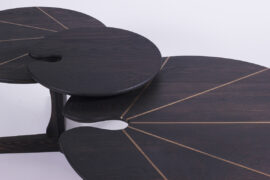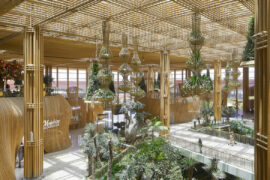“In Australia, our diversity as a people is our design strength. We have a remarkable Indigenous heritage and also one of the youngest modern countries, post-colonisation,” says Plus Architecture’s Brendan Murray.

March 22nd, 2022
Having recently taken up the role of principal with Plus Architecture, Brendan Murray draws from his diverse experience as an architect, enthusiastic traveller, cross-cultural collaborator, and student of life.
He shares with Indesignlive his experience of growing up into the Australian architecture industry, and his observations of design culture in countries such as Singapore, the UK, Spain and Denmark.
Q: Can you share your thoughts on the Australian architecture and design industry at large?
Brendan Murray: My generation of architects exists in a really interesting time. At the beginning of our careers, the region’s economy was in boom. Many of us had the opportunity to work locally, building experience on real constructed projects, and also work internationally from a home base while gaining knowledge abroad.
In my student days, a few amazing things happened that gave us confidence: an Australian (Glenn Murcutt) won the Pritzker Prize, the world came to town for the Sydney Olympics, and our economy had an unbroken stretch of growth. Suddenly Australians didn’t feel like we lived in an irrelevant global backend. The cultural cringe started to fade, and it planted the idea that we Aussies had something to contribute.
In Australia, our diversity as a people is our design strength. We have a remarkable Indigenous heritage – the oldest continuous civilisation in the world – and also one of the youngest modern countries, post-colonisation. What a phenomenal gift this is, for us as a people and for designers!
I think our creative edge comes from growing up in a multicultural society; having the openness to try new things, fusing ideas from different places, and understanding different points of view. Food, music, beliefs, values, language and design – all these pursuits are entwined. While we’re having these important conversations, we’re still writing our story and figuring out how we should do things here. It’s a very fertile place and time for creatives.

Your international perspective is gained through collaborations with European, South-east Asian and Chinese practices. Can you offer an insight into the unique influence these have on a world stage?
I love that these places have proud traditions, and know who they are. By reflecting on who they are culturally, they can work together for the collective benefit, and be clear about their global contribution. Interestingly, when you look at the architectural models produced by various design cultures, it can give you an indication of the relative emphasis they have a focus on: ‘systems’ in London, ‘beauty’ in Barcelona, or the ‘people’ in Copenhagen, for example.
In our region, I’ve found Singapore particularly interesting as they’ve had similar identity challenges to us over the years, but have found strength in their unique mix of diverse people, geography, focus on sustainability and work ethic.

What have you learnt along the way?
A pivotal moment for me came 10 years ago, when I had the fortune of joining the Australian Institute of Architects’ Dulux Study Tour for emerging architects. I travelled to London, Barcelona and Copenhagen with four others who remain close friends to this day. Ours was a fairly diverse group, with a couple of Australian architects of Irish backgrounds, Korean background and Jefa Greenaway, one of the few registered Indigenous architects in the country. It was like holding a mirror up to your own reflection as a practicing Australian architect. I came away feeling that we were up there with the best in the world.
One of the lessons from this trip was, these countries do a great job at establishing a strong design language – working together to cross-promote their collective quality on a world stage. I think Australia could take a leaf out of their books. For example, when we think about Scandinavian, Japanese, and Singaporean design, we could easily identify what we most love about their approaches.

How do these diverse experiences influence your design work today?
Diverse thinking and generalist training are key to solving the so-called ‘wicked problems’ of the 21st Century. It’s also how we achieve design excellence, creativity and innovation, in our pursuit of sustainability in all its forms, and navigating our post-COVID-19 reality.
Listening is key. Studying cross-disciplinary research at my university’s school of music, in music and architecture, helped me see what we do from another perspective, and laid the foundations for working on challenging problems – talking and collaborating with people who speak a different jargon to you.
It’s important to gain diverse experience across different building typologies and sectors too. I’ve constantly seen the innovation that happens when firms solve problems in sectors beyond their usual. In fact, I’ve led a team on a project that won ‘best transport building in the world’; it was the first time we’d worked in this sector, outside the firms’ traditional area of expertise.
I’ve been fortunate to build a portfolio across residential, commercial, public, cultural, urban, heritage adaptive re-use and transport projects, and look forward to applying this broad expertise at Plus Architecture.

Brendan Murray was recipient of the 2015 NSW Emerging Architect Prize and recently joined Plus Architecture as a principal in Sydney.
Plus Architecture
plusarchitecture.com.au
Photography
Courtesy of Brendan Murray
We think you might like this article about architect, Whare Timu, of Warren and Mahoney.
INDESIGN is on instagram
Follow @indesignlive
A searchable and comprehensive guide for specifying leading products and their suppliers
Keep up to date with the latest and greatest from our industry BFF's!

A curated exhibition in Frederiksstaden captures the spirit of Australian design

Gaggenau’s understated appliance fuses a carefully calibrated aesthetic of deliberate subtraction with an intuitive dynamism of culinary fluidity, unveiling a delightfully unrestricted spectrum of high-performing creativity.
An initiative of Australian Wool Innovation (AWI), the Prestigious Woolmark Prize, has been won by young Shanghai Fashion Designer, Qiu Hao.
The internet never sleeps! Here's the stuff you might have missed

The second installment in our three-part series on collaborations between the world’s best designers and the American Hardwood Export Council

Working far from home, Paul von Chrismar from Büro Architects has been integral in the creation of a grand Buddha in Bhutan that makes an enduring impact on that country and the world.

Winner of the INDE.Awards 2025 Best of the Best, Terminal 2 Kempegowda International Airport Interiors by Enter Projects Asia and SOM showcases 12,000-square-metres of biophilic design, featuring nine kilometres of handwoven rattan in a sustainable, world-class passenger experience.